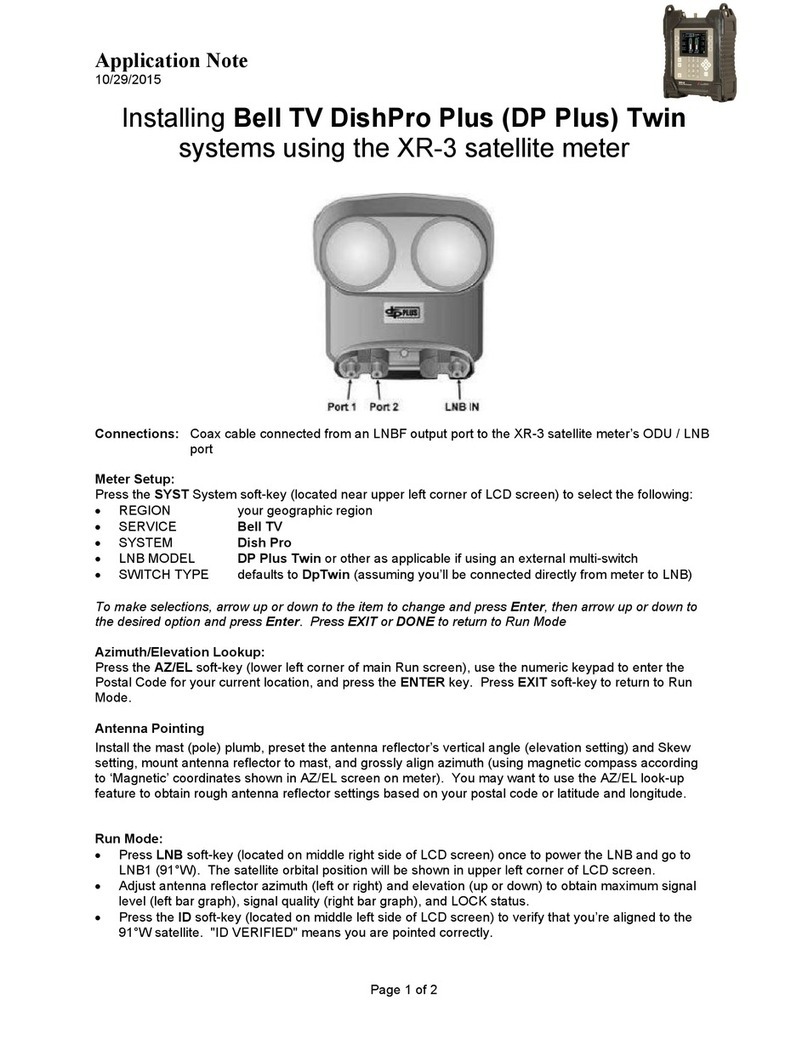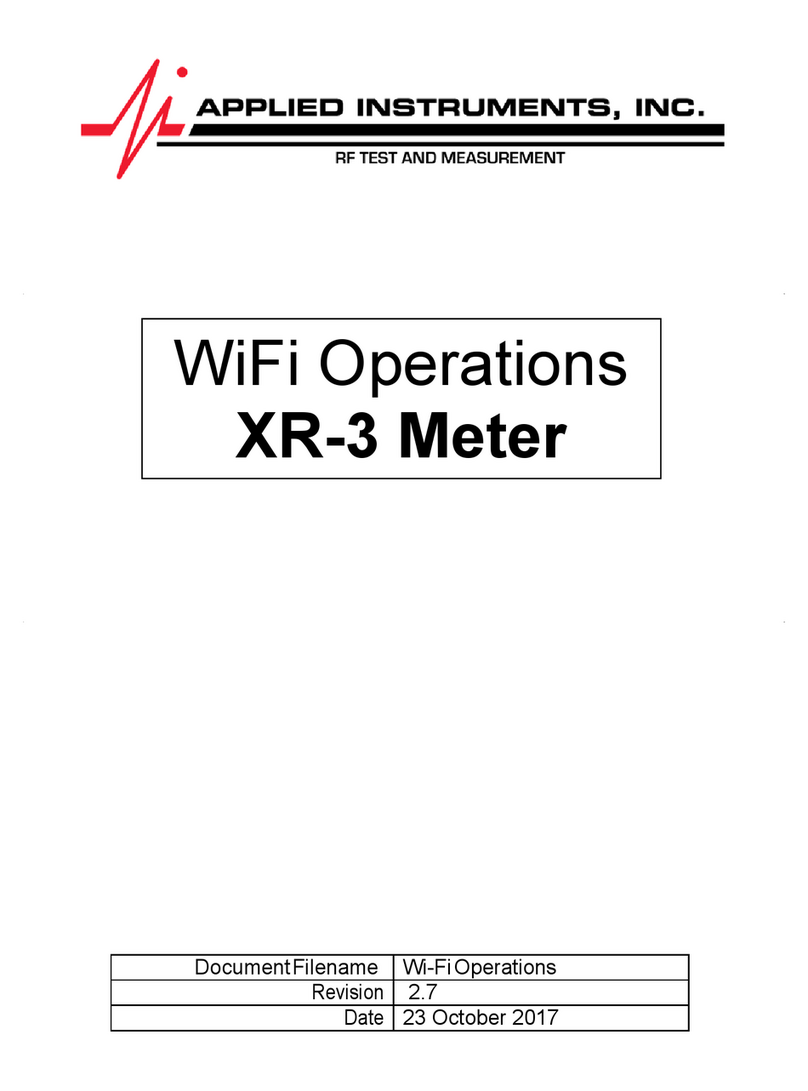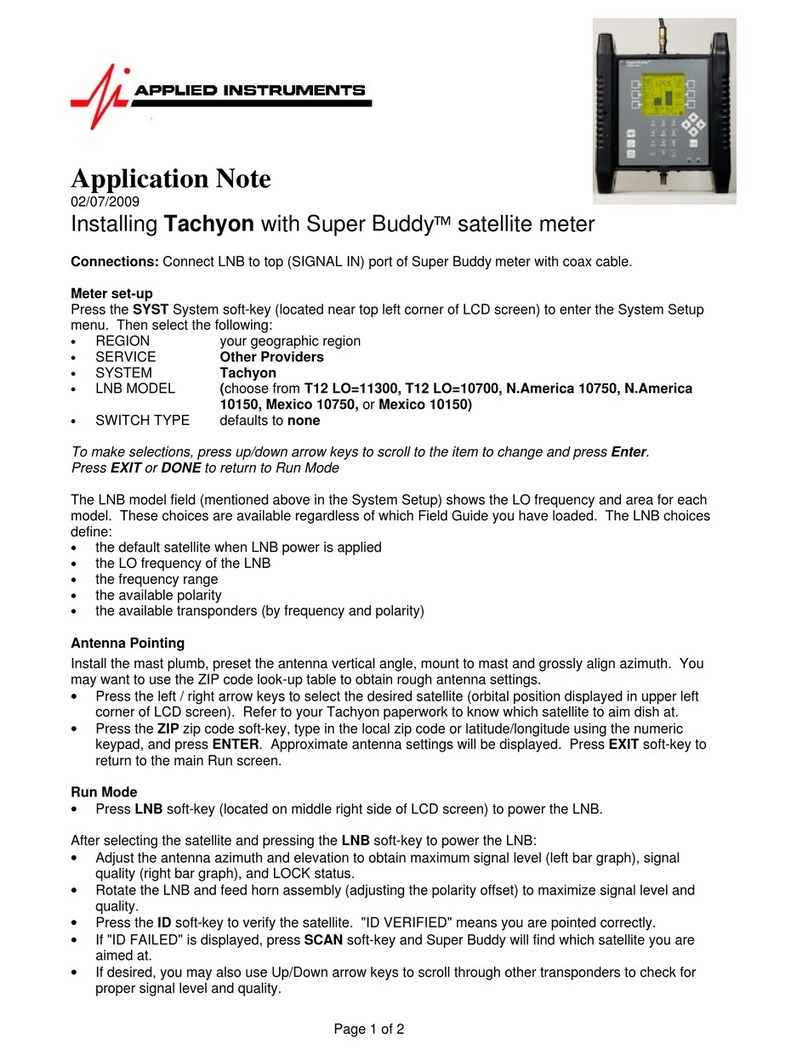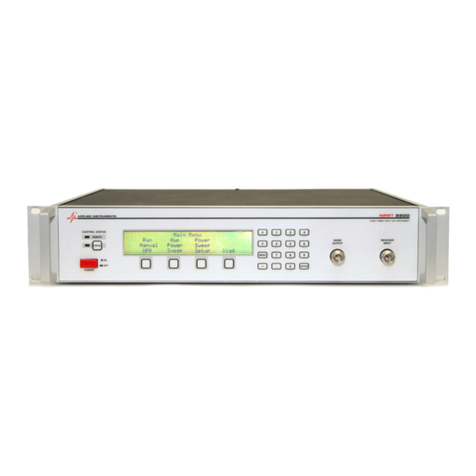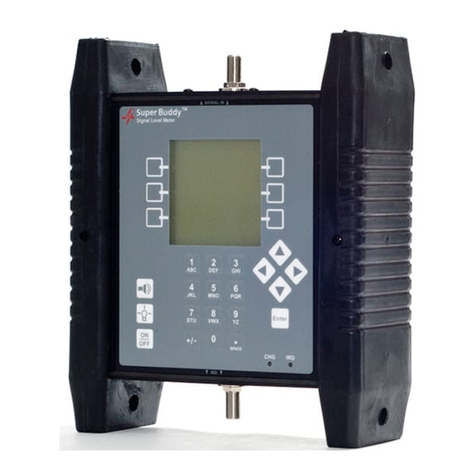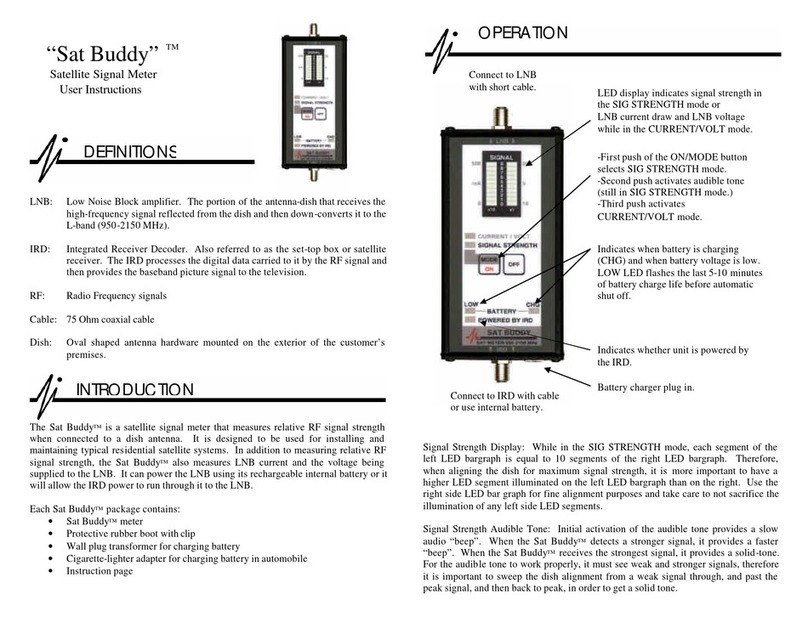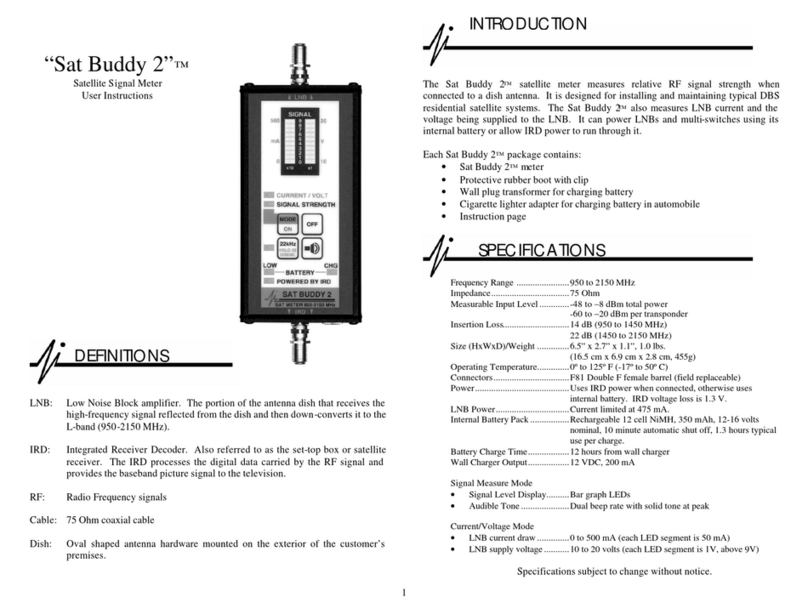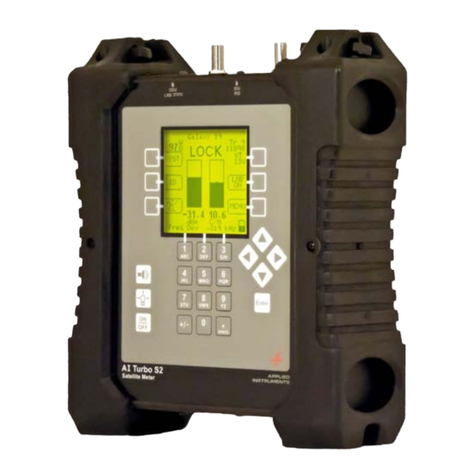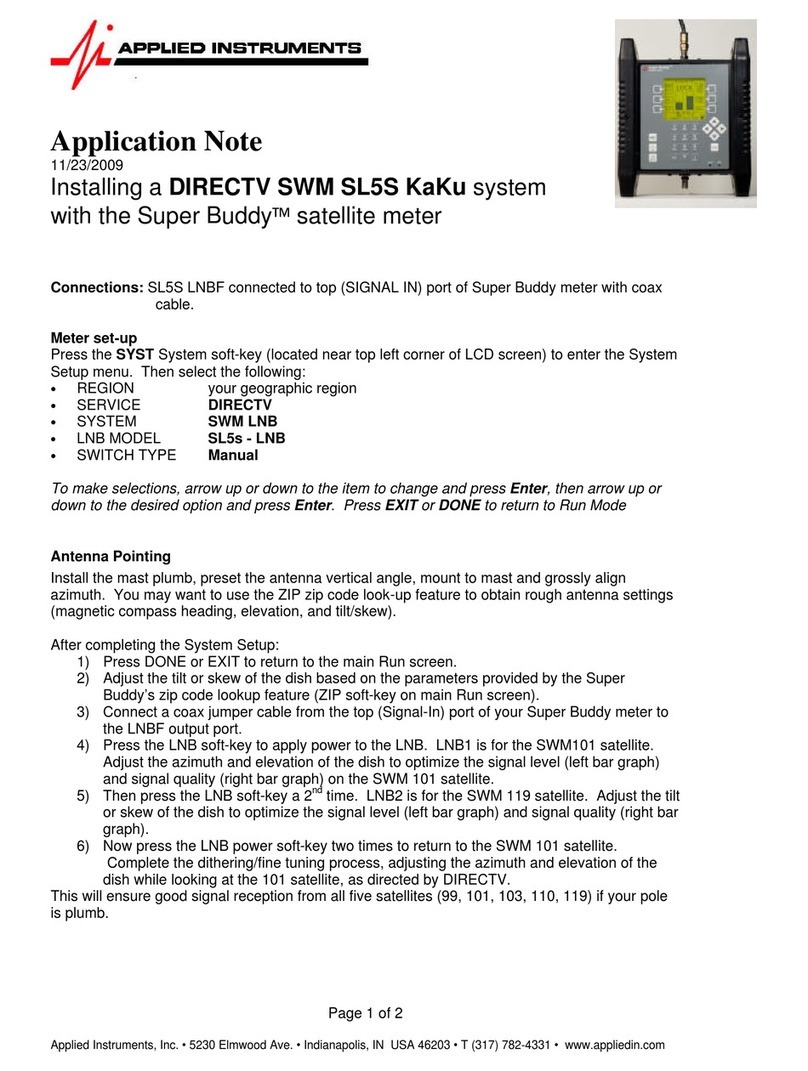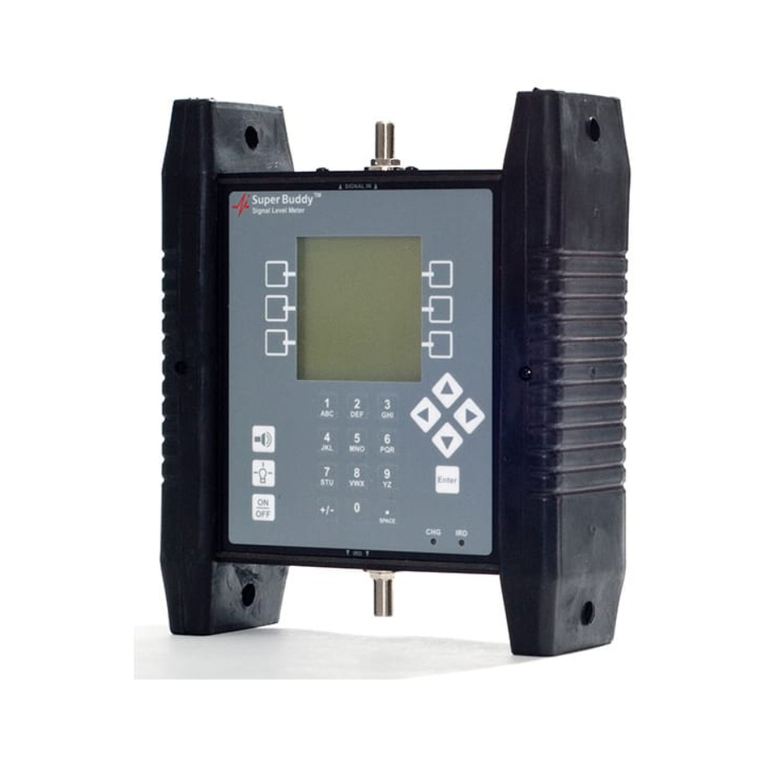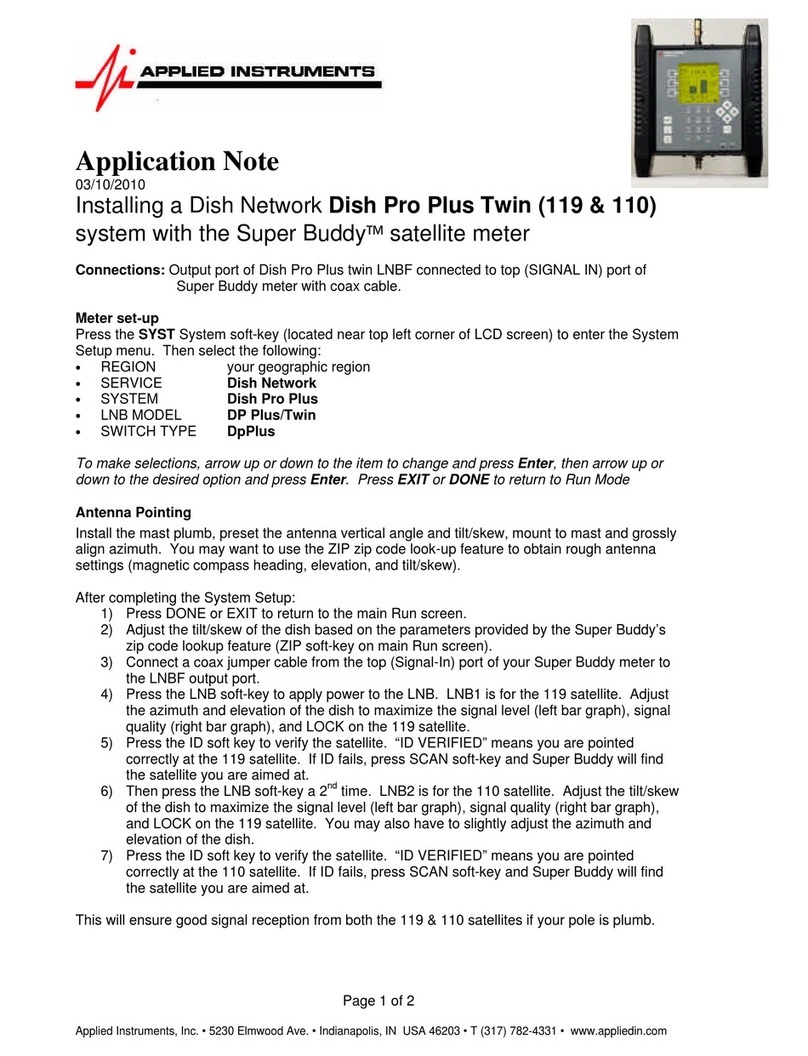
Frequency Range........................950 to 2150 MHz
Impedance..................................75 Ohm
Measurable Input Level .............-48 to –8 dBm total power
-60 to –20 dBm per transponder
Insertion Loss.............................14 dB (950 to 1450 MHz)
22 dB (1450 to 2150 MHz)
Size (HxWxD)/Weight...............6.5” x 2.7” x 1.1”, 1.0 lbs.
(16.5 cm x 6.9 cm x2.8 cm, 455g)
Operating Temperature..............0º to 125º F (-17º to 50º C)
Connectors.................................F81 Double F female barrel (field replaceable)
Power.........................................Uses IRD power when connected, otherwise uses internal
battery. IRD voltage loss is 1.3 V.
LNB Power................................Current limited at 475 mA.
Internal Battery Pack..................Rechargeable 12 cell NiMH, 350 mAh, 12-16 volts nominal,
10 minute automatic shut off, 1.3 hours typical use per
charge.
Battery Charge Time..................12 hours from wall charger
Wall Charger Output..................12 VDC, 200 mA
Signal Measure Mode
•Signal Level Display..........Bar graph LEDs
•Audible Tone......................Dual beep rate with solid tone at peak and when balanced
Current/Voltage Mode
•LNB current draw ..............0 to 500 mA (each LED segment is 50 mA)
•LNB supply voltage ...........10 to 20 volts (each LED segment is 1V, above 9V)
Specifications subject to change without notice.
2
MODES
•SIGNAL STRENGTH: Measures and displays the signal strength on input
connector [1]. Each segment of the left LED bar graph is equal to 10 segments of the
right LED bar graph. To align the dish for maximum signal strength, obtain the
highest possible measurement on the left LED bar graph and use the right side LED
bar graph for fine alignment. The measurement displayed is relative signal strength;
more is stronger. The numeric value displayed is NOT tied to the IRD’s signal quality
value. However, after a few installs, you may learn to correlate the value on the Dual
Buddy™ to an approximate IRD value.
•COARSE BALANCE: Measures and displays the signal strength on input
connectors [1] & [2]. The measurement sensitivity is fairly coarse (4 dB per bar). The
left LED bar graph corresponds to input [1] and the right with input [2]. You should
achieve a peaked and balanced alignment in the COARSE BALANCE mode before
going to the FINE BALANCE mode.
•FINE BALANCE: Measures and displays the signal strength on inputs [1] & [2].
Because the FINE BALANCE mode is so sensitive (0.8 dB per bar), if you have not
previously peaked and balanced the alignment in the COARSE mode, the
measurement may be off scale and displayed as a flashing bar (top bar flashing for
above scale, bottom bar flashing for below scale). If this occurs, go to the COARSE
BALANCE mode to peak and balance the coarse alignment again.
•CURRENT/VOLT: Current drawn by the LNB(s) is displayed on the left LED bar
graph. Voltage being supplied is displayed on the right LED bar graph.
If the Dual Buddy™detects an over-current situation, it will switch to
CURRENT/VOLT mode and flash the highest LED segment on the CURRENT side.
LNB power will be shut off except for retesting every 4 seconds.
If the Dual Buddy™detects a voltage from the IRD greater than 20V or less than 10V
while in the CURRENT/VOLT mode, it will flash either the highest or lowest LED
segment on the VOLT side, respectively.
AUDIBLE TONE
•Press the audible tone button to turn the tone on or off. There are three tones: slow
beep, fastbeep and solid. The function depends on the measurement mode:
•In SIGNAL STRENGTH mode: The Dual Buddytracks the lowest and highest
signal strength found and uses a relative strength method to control the tone. In this
way, it adapts to provide the best feedback for the situation, but it needs to see both a
weak and a strong signal to work best. If you start from a weak signal position and
slowly sweep the dish up to and beyond the strongest position, the tone will change
from slow, to fast, solid and then fast again. The meter has now learned what the
highest peak is and when you move the dish back to the solid tone you will be at the
best position. If you start from a strong signal position, it will provide a slow beep
until it learns what the true minimum is.
•COARSE and FINE BALANCE: The audible tone beeps faster as the signal
strength of inputs [1] and [2] get closer to being equal. The audible tone will be solid
when the inputs are closely balanced.
3
SWITCH CONTROL
•Normal 22 kHz: A quick push of the 22 kHz button provides a 22 kHz tone to
the input [1] connector for controlling 22 kHz switches or universal LNBs.
Another quick push of the button turns off the 22 kHz tone.
•DiSEqC™: To control Eutelsat DiSEqC™ standard compatible switches, push
and hold the 22 kHz button for 3 seconds. The Dual Buddy™ beeps and the
adjacent LED flashes. With each new press of the button, a new DiSEqC™
command will be sent and the LED flash rate will change to indicate the LNB or
switch selection made. The commands are sent on input connector [1] only.
Flashes DiSEqCswitch DishProtwin DP 34/44switch
1A110°Dish 1
2B119°Dish 2
3C110°Dish 3
4D119°Dish 3
Mount the dish and adjust the azimuth, elevation, and skew per the instructions of the
service provider and hardware manufacturer.
•Singlesatellite:
1) Connect the Dual Buddy’s input [1] to the LNB.
2) Adjust the dish azimuth until signal strength is maximized on the display
or audible tone.
3) Adjust the dish elevation until signal strength is maximized.
•Dual Satellite:
1) Connect two cables from the LNB to input connectors [1] and [2].
2) In SIGNAL STRENGTH mode, adjust the dish until signal strength
on input [1] is maximized on the display or audible tone.
3) Select COARSE BALANCE mode and make small adjustments to
balance the left (input [1]) and right (input [2]) LED bar graphs or
until a solid audible tone is obtained.
4) Select FINE BALANCE mode and make small adjustments to
balance the left and right LED bar graphs or until a solid audible tone
is obtained.
DIRECTV™SINGLE SATELLITE:
•Follow DISH ALIGNMENT instructions above.
DIRECTV™MULTI-SATELLITE:
•Dual Cable Input: Follow DISH ALIGNMENT instructions above.
•Single Cable Input: Signal received without the 22 kHz tone activated is from the
101º satellite. Signal received with the 22kHz tone activated is from the 119º/110º
satellite signal.
Note: For North American DIRECTV™ multi-satellite antenna installations, do not try to
obtain a perfectly balanced measurement on the Dual Buddy’s ™ LED displays. At the
time of printing these instructions, there were 16 transponders measured by the Dual
Buddy™ from 101º and only 13 transponders from the 119º/110º satellites. We
recommend peaking the 101º feed and then bringing the 119º/110º feed to a level no more
than one bar less in the COARSE BALANCE mode and about 3 bars less in the FINE
BALANCE mode.
4
SPECIFICATIONS
To IRD (unless using internal battery)
Battery Charger
Input
Audible Tone
ON/OFF
Measurement
Bar Graph
LEDs
Field Replaceable
F-81 Double F
Female Barrels
Mode Selection
LNB/Switch
Control
